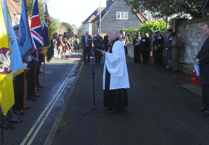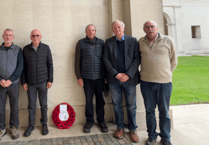As the veterans and dignitaries gathered at Farnham’s war memorial in Gostrey Meadow on Sunday fell silent at 11am, their thoughts turned to those who gave their lives in conflict.
Few, however, may have realised that the tradition of pausing in silence began here, in Farnham’s own Castle Street, more than a century ago.
For recently discovered documents have almost certainly proved that the first ever two-minute silence to commemorate the war dead is believed to have begun here, in the town’s own Castle Street, more than a century ago.
Farnham has a proud record of firsts. It was home to Britain’s first Cistercian monastery, Waverley Abbey, founded in 1128 beside the River Wey. Nearly eight centuries later, it became England’s first World Craft Town, joining an international network of creative communities supported by the European Crafts Alliance and UNESCO’s Creative Cities programme.
But perhaps the town’s most poignant first came on Wednesday, May 10, 1916, when it hosted the world’s first two minutes of hush to honour the dead.
That day, as veterans, civic dignitaries, townsfolk and visiting farmers gathered in Castle Street for an agricultural fair in aid of the British Red Cross, a hush fell over the crowd. At 11am the bustle stopped. Heads were bowed and hats removed as Farnham paused to remember those who had fallen in the Great War, those still serving, and the wounded and missing.
A document discovered in the National Archives confirmed that the silence was part of the event’s official programme.
Local historian Maurice Hewins, speaking to the BBC, said the scene would have been “happy chaos” until that moment when the bugle band finished playing and silence descended. “Press reports said it was very moving,” he said. “Nothing could be heard except some cattle and the occasional movement of a motor car.”
The Museum of Farnham’s manager, Lauren Wayland, said the discovery had brought the 1916 event vividly to life. “It really is quite emotional to imagine the energy in that street when the silence was held,” she said. “There must have been hundreds of people in that crowd who had been impacted by the horrors of war.”
She added that the decision to hold a silence reflected the sombre national mood at the time, as this was part way through the war and people were not in the mood to have fun and games. The silence acknowledged what was happening and honoured those who had lost their lives.
By 1916, Britain had suffered heavy losses at the Battle of Ypres, and conscription had just been introduced. The organisers of the fair, a Red Cross fundraiser, saw the need for a gesture that balanced community spirit with solemn recognition of sacrifice.
Hundreds are believed to have taken part, lining Castle Street from its Georgian buildings down to the market at the bottom of the hill. For two minutes, only the faint sounds of the town remained. When the fair resumed, its tone was subdued but resolute.
A black plaque with gold lettering now marks the site of that first silence, commemorating Farnham’s role in what became a worldwide tradition.
Three years later, in November 1919, King George V called for a nationwide two-minute silence to mark the first anniversary of the Armistice. His message urged people across the Empire to pause at the eleventh hour in remembrance.
Mr Hewins said that Farnham’s 1916 gathering may have helped shape that idea. Though the King’s proclamation gave the act national prominence, Farnham’s 1916 event remains the earliest known example of a community-wide silence for the war dead.
“The national silence probably overshadows Farnham’s role,” Ms Wayland told the BBC, “but it’s important people know this started here — in our town, among ordinary people moved by extraordinary loss.”
Each November, when the nation falls quiet at 11am, few realise that the tradition began in Farnham. What started as a local pause amid the sounds of livestock and motorcars has become one of the most powerful acts of remembrance in the world.





Comments
This article has no comments yet. Be the first to leave a comment.